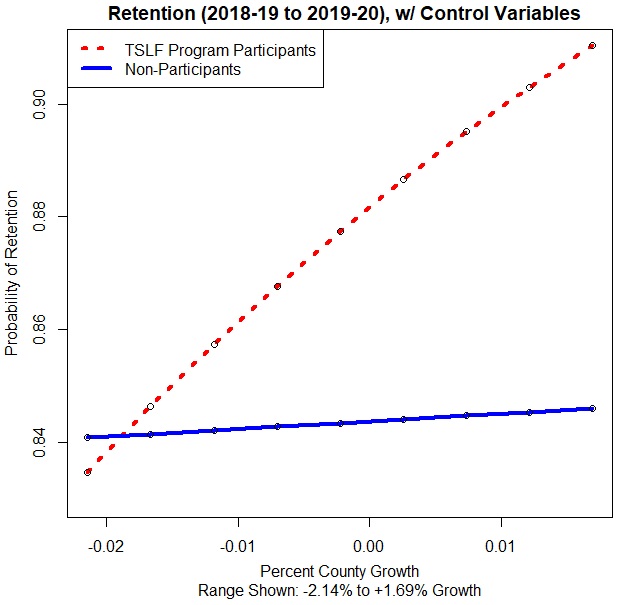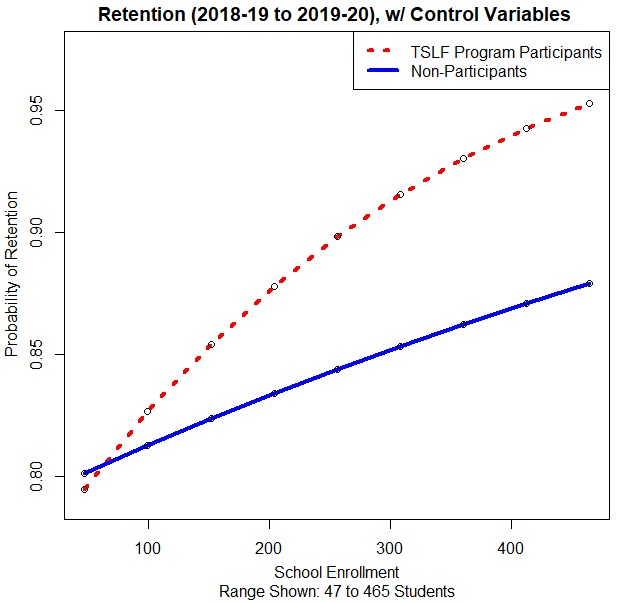08 Apr ND Teacher Shortage Loan Forgiveness Program Evaluated by NDUS-IR
As I’ve written before, teacher shortages and turnover remain persistent challenges in North Dakota. One program that has aimed to address these challenges is the Teacher Shortage Loan Forgiveness (TSLF) Program. Teachers with education debt could have $4,500-$6,500 forgiven via a series of payments to their lender as long as their remained at their workplace. Thus, this program incentivizes teachers to remain in their schools.
Does loan forgiveness increase teacher retention? Answering this question is not simply a matter of comparing loan forgiveness recipients with other teachers. Loan forgiveness awards went to teachers at rural schools, given their greater shortage and turnover challenges. Thus, loan forgiveness recipients should be compared with other rural teachers (apples-to-apples) and not urban teachers (apples-to-oranges). I selected the comparison or “control group” of teachers based on their similarity to loan forgiveness recipients when it came to rural environment, age range, years of experience, salary range, and a few other details. I’ve also controlled for these and other variables in my analyses, allowing me to isolate the impact of loan forgiveness on teacher retention.
Taking the list of loan forgiveness recipients and the control group of teachers, I looked to see where they were working in 2018-2019 (when recipients were chosen). Next, I investigated where these teachers are currently working. Some teachers are working at the same school. Others have moved to another school. Some others are nowhere to be found in the data, suggesting they may have left North Dakota and/or the teaching field.
I used a statistical technique called logistic regression to determine whether loan forgiveness increased teacher retention. I also tested whether this effect depended on community rurality. Although all loan forgiveness recipients and control group teachers were in rural environments, some worked in tiny communities. Others worked in growing rural counties with tens of thousands of residents and hundreds of students at the school/district level. I created a “rural index” so that I could capture whether loan forgiveness benefits depended on rurality. The index incorporated county population, county growth, and enrollment headcounts at the school and district levels.
A distinct pattern emerged from my analyses. Namely, loan forgiveness improved retention of teachers in moderately rural environments. However, that could not be said about teachers in extremely rural environments, who may need a more substantial intervention to aid their retention. For tiny schools in tiny townships, loan forgiveness is not enough on its own to reduce teacher turnover.
To illustrate this pattern, please see two graphs. Here, I plot the effects using two easy-to-understand measures of rurality: county growth and school enrollment. Although my model with the rural index was the most powerful, it’s good to look at patterns with straightforward measures too.

The first graph shows the pattern of teacher retention depending on one year of county growth (the x-axis). The y-axis is the probability of teacher retention. In shrinking rural counties, loan forgiveness has weak benefits, if any. In growing rural counties, loan forgiveness recipients are better retained. In a county experiencing 1.69% growth, teachers are retained 84.6% of the time. However, teachers with loan forgiveness are retained 91% of the time.
The second graph shows the pattern of teacher retention dependent upon school enrollment (x-axis). Tiny schools are more often found in extremely rural communities. Within tiny schools, loan forgiveness has minimal benefits. As school size increases, the benefits of loan forgiveness emerge. For instance, in a school with 395 students, teachers are retained 86.8% of the time. Meanwhile, teachers with loan forgiveness are retained 93.9% of the time.

The strong effects of the rural index – the measure capturing county population and growth as well as school and district size – are worth discussing. Using this inclusive measure, I found that teachers in moderately rural environments are retained 86.1% of the time. Meanwhile, teachers with loan forgiveness are retained 95.3% of the time. What does this finding ultimately mean? In brief, if you provided loan forgiveness to twenty teachers in moderately rural schools, you’d still have nineteen of them around the following year. That is two more teachers than the seventeen you’d have if you’d not offered loan forgiveness to any of them.
Ultimately, loan forgiveness is a promising method of increasing teacher retention in the right environments. While teacher turnover remains a difficult-to-solve challenge in our extremely rural communities, loan forgiveness does bring relief to our moderately rural communities.
============================================================================
 Dr. Ellie Shockley is an Educational Data Warehouse Specialist on the NDUS institutional researcher team. In this capacity, she also works closely with the Department of Public Instruction (PK-12) and the Information Technology Department. She often responds to education data requests that come from state agencies or from outside of state government. Her work ranges from pulling raw data and sharing it according to our best practices, to conducting complex statistical analyses in order to answer research questions, to assisting with inter-agency collaborations related to education data, and more. Dr. Ellie Shockley is an Educational Data Warehouse Specialist on the NDUS institutional researcher team. In this capacity, she also works closely with the Department of Public Instruction (PK-12) and the Information Technology Department. She often responds to education data requests that come from state agencies or from outside of state government. Her work ranges from pulling raw data and sharing it according to our best practices, to conducting complex statistical analyses in order to answer research questions, to assisting with inter-agency collaborations related to education data, and more. |


